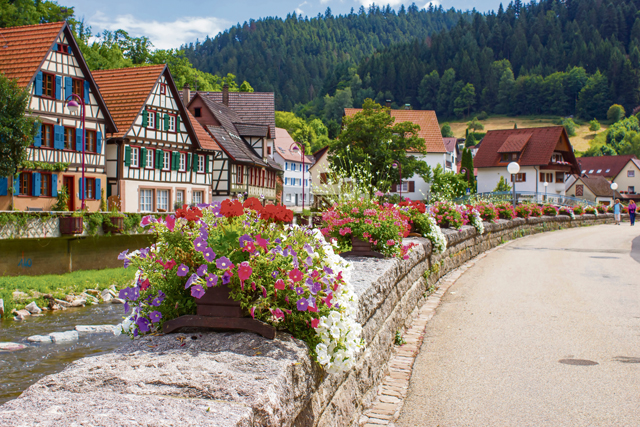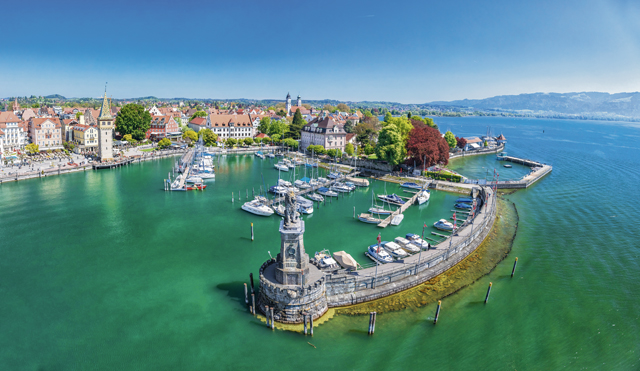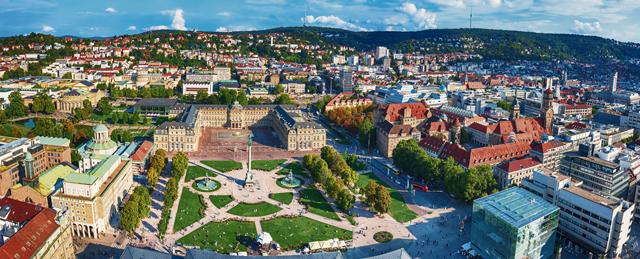
State of the Art is a series introducing Germany as a whole, but also highlighting an individual state or “Bundesland” every month.
After the fall of the Berlin Wall in 1989, both German countries reunited in 1990. The Federal Republic of Germany (West Germany) included 11 states and Berlin, in its geographically isolated location. The German Democratic Republic (East Germany) was comprised of five states and today’s Germany has a total of 16 “Bundesländer.”
After reunification Berlin again became the capital and the seat of the Federal Parliament (Bundestag) and the representative body of the states (Bundesrat). Olaf Scholz of the majority Social Democratic Party (SPD) is the elected Federal Chancellor of the country with 84 million inhabitants.
This month we will make a large leap back down south to the State of Baden-Württemberg, a neighbor to Rheinland-Pfalz towards the East, which calls itself the ‘sunny side of Germany.’ The state has an area of 35,000 square kilometers and just over 11 million inhabitants.
The capital is Stuttgart with its Landtag (State Parliament). Winfried Kretschmann of the Green Party has been Minister President since 2011 and was recently re-elected for his third term in office.
City of Squares
Our journey will start in Mannheim, across the Rhein River from Ludwigshafen in Rheinland-Pfalz, which is the largest city in the Baden part and the second largest in the whole state. It has 311,830 inhabitants and lies on both the Rhein and Neckar Rivers.
As a former Residential city (1720–1778) and its Baroque palace, one of the largest palace structures in the world, it is now the economic and cultural center of the Metropolitan Region Rhein-Neckar with a total of 2.4 million inhabitants.
Mannheim is well known for its chessboard layout of the city center, where streets do not have names, but are distguished by squares such as A6 or Q9. This often leads to confusion for the postal service or when stating your address and is sometimes called the City of Squares. Since 1896 it has had a population of over 100,000 residents and evolved into an important industrial and commerical city. As a significant rail hub between Frankfurt/Main and Stuttgart, especially for ICE trains, it has the second largest marshalling yard and a leading domestic port.
Apart from the palace, which now houses one of the two universities, the Wasserturm (water tower) is the most prominent landmark in the city. It is situated in the Augusta Anlage, a park with fountains colorfully illuminated at night and next to the Rose Garden, a theater and concert hall. The tower was built upon the initiative of Benjamin Thompson of Massachusetts, based on a shortage of drinking water and construction was completed in 1889. The area around the 60-meter-high and 19-meter circular structure is also venue to the annual Christmas Market.
Further attractions are the Reiss-Engelhorn Museum, the Art Hall and the Technomuseum, which has a popular planetarium. The pedestrian area in the “Planken” (the squares) is home to department stores and a narrow road next to the Marktplatz is lovingly referred to as “Kücük Istanbul – Little Istanbul” with typical Turkish restaurants and shops. Due to the high percentage of descendants of Turkish guest workers that came to Germany in the 1960’s, some in the third or fourth generation, you may also see signs in Turkish in regular shops and stores. The Maulbeerinsel and Friesenheimer Insel have become popular recreational islands. This year Luisenpark/Spinelli Park host the German National Garden Show which started in April. See, https://www.mannheim.de and https://www.buga23.de/englisch
Lose your heart in Heidelberg
It is not surprising that Heidelberg along the Neckar River gave name to a popular German folksong “I lost my heart in Heidelberg.” Its picturesque market square with a church, a charming and historical walking area, narrow alleys, pubs and restaurants as well as a magnificent castle towering above the city and its famous bridge, attract over 11 million international visitors a year. The city is also home to one of the oldest and elite universities in Germany, founded in 1386, that specializes in medicine, research, linguistic and philosophy. About 39,000 students make up almost 25 percent of the total population of 160,000 and create a young, fun and bustling atmosphere in the city. For more information, see https://www.heidelberg.de/english/Home/Visit.html
UNESCO City of Media Arts
Karlsruhe, the third largest city in the state with 306,000 inhabitants is a further city planned during the Residential era and construction began in 1715. It is also referred to as “Fächerstadt” (fan city) based on 32 streets that fan out from the magnificent palace and gardens. In 2019 it received the international UNESCO Creative Cities Network Award as city of media arts and has been in exchange with media arts and creative sites around the world.
The city has six universities, including faculties for design, arts and technology. It can easily be traveled by tram, has a large pedestrian zone and recently opened its first subway line. The zoo across from the train station is a popular spot to see wild animals, ride a gondola on the lake or picnic in the park. Further attractions include a botanical garden, a rose garden, a Japanese Garden and an aqua park. There are several lakes around the city or you can enjoy beaches along the Rhein River in the vicinity. A Festival of the Senses takes place every year in the summer. Also see, www.karlsruhe.de.
Traveling southbound we’ll first encounter soft rolling hills and the picturesque town of Ettlingen along the Alb River. The town with semi-timbered houses, a Baroque castle and a lively market square is considered to be the gateway to the Nature Reserve Black Forest Center/North. It served as a strategic road connection as early as Roman times and a Roman bath and a Neptune stone are located underneath the Martinskirche (church). It is a great place to stop for a shopping or coffee break enroute to the Black Forest.
Cuckoo clocks and a Bommel
The first thing that may come to your mind when thinking about the Black Forest might be the famous cuckoo clocks. The largest clock is located in the Eble Uhrenpark in Triberg, was built in a ratio of 60:1 and can be visited inside and out. The largest clock wheel has a diameter of 2.60 meters (8.5 feet), it weighs six metric tons and has an eight meter (26 feet) long pendulum.

The Black Forest region has a long tradition of manufacturing clocks, and it is said that the first clock with cuckoo sounds belonged to Kurfürst August of Saxony as early as 1629. Mass production and fine tuning of these clocks is attributed to Franz Ketterer around the mid 1850’s.
The Schwarzwald is Germany’s highest and largest low mountain range with an area of 6,000 square kilometers and up to an altitude of 1,493 meters (4,900 feet). The range stretches south, just along the Baden winegrowing region and the Rhein River, a natural border to Lorraine in France. The name Black Forest is derived from the very tall and dark fir trees, which make the region appear rather dark or even black. The town of Freudenstadt atop a plateau is a popular aerial spa town, famous for its market square and starting point for exciting hiking trails.
Traditional houses in the region are built with dark timber, but often decorated with artistic window shutters and balconies hung with colorful flowers. Some women wear traditional dresses and to top things off, straw hats with giant, bright red pompoms called “Bommel.”
One of the famous valleys in the south of the Hochschwarzwald (High Black Forest) is the Ravenna Schlucht (gorge) north of the city of Freiburg in the Breisgau Region. Freiburg is another popular university town, has small water canals throughout the city and is famous for its large farmer’s market at the church square. Titi See, a mountain lake, is nearby and the city is famed for being the hottest town in Germany, both in the sense of temperature in the summer and its bustling student flair. It is also gateway to other tourist destinations such as Colmar in France, is close to Switzerland at the source of the Rhein River, and lies enroute to Germany’s largest lake Bodensee (Lake Constance).
Cruise the lake and discover pile dwellings
Lake Constance is at Germany’s most southern end and borders Switzerland to the south and Austria to the southeast. In the summer it can have an almost Mediterranean climate, some shores are aligned with palm trees and exotic flowers. Insel Mainau is famous for its monastery and is called the “Blumeninsel” (island of flowers). In addition to various floral displays, also famed for orchids, the island is also venue to classic concerts and festivities. You can hop on a ferry from the north shore and stop for a break on your way to Konstanz, the city that gave the lake its English name.

Konstanz borders Switzerland and has a well-preserved Middle Age core in addition to several museums and a promenade along the shore, where visitors are greeted by Imperia a huge statue holding a flame.
The town of Unteruhldingen on the north shore boasts an impressive outdoor archaeological museum with 23 reconstructions of pile dwellings. The dwellings from the Bronze and Stone Ages tell of the lives and times of our ancestors up to 7,000 years ago who settled at the lake and made a living out of fishing and trading. https://www.bodensee.eu/en/what-to-do/map-of-lake-constance/lake-dwelling-museum-unteruhldingen
Other towns worth a visit along the lake are Meersburg with an impressive castle atop, a cozy walking area with medieval character and you can spend a night at a Middle Age hotel with knights in shining armor. Take a relaxing mini-cruise with a view of the snowcapped Swiss Alps in the background to Friedrichshafen or to picturesque Lindau, located on a peninsula. The Austrian town of Bregenz can easily be reached by boat or you can continue your voyage onto Romanshorn in Switzerland. The 260-kilometer-long biking trail around the lake is one of the most popular routes in Germany and leads you to cultural highlights in three countries.
Caves, spas and Porsche
Traveling back north you can enjoy a leisurely drive along the “Schwäbische Alb” with soft rolling hills and green pastures with grazing sheep. The town of Calw, birthplace of German author Hermann Hesse, is worth a stop to admire its medieval town center. The Swabian Alb, which stretches 200 kilometers, is well known for its landscape of 2,500 caves, some of them with the oldest known works of art carved into the rock and the region is proud of its 40,000 years of culture. Twenty of the caves are open to the public and the most popular cave is Wimsener Höhle that can be toured by boat. In addition, there are a number of castles in the region, a Gaelic village is under construction and there are several spa towns with geothermic springs. For details, see https://www.swabianalb.info/

The capital of the state lies in the “Stuttgarter Kessel” (valley) with 626,000 inhabitants and is the sixth largest city in Germany. The city section Cannstatt dates back to Roman times and ruins of the former castell are still visible. Cannstadt is also the venue to Germany’s second largest beer festival “Cannstadter Wasen.”
The city is famed for its numerous theaters, an opera house and musical performances at the stage center near the airport, has a castle and a large pedestrian and shopping area downtown. It is also well known for its automobile manufacturers such as Porsche and Mercedes-Benz (both with museums) and companies that produce accessories, such as Bosch electronics, and are the region’s largest employers.
Other attractions are three palaces, a Chinese Garden and the “Wilhelma,” one of Germany’s largest zoos and botanical gardens. Enjoy a ride with the nostalgic rackrail “Zacke” built in 1884 and a spectacular view over the city or visit the “Stuttgarter Weindorf” and the indoor market hall. Due to its location in the valley, Stuttgart can have a damp climate with occasional smog, which led to very restrictive limitations on diesel powered vehicles. https://en.stuttgart.de/.
Legos, the highest church tower and a Danube cruise
Traveling towards the East, the small town of Günzburg lies along the route, well-known for its Legoland Park, with colorful exhibitions, rides and attractions for young and old, and a miniature wonderland of models of cites around the world.
The City of Ulm, just short of the border to Bavaria is another historical city worth exploring. The Ulmer Münster, a cathedral built in Gothic style, has the highest church tower in the world at a height of 161 meters. Climb the 768 steps to a platform at 143 meters altitude for a fantastic view of the medieval city center. Stroll through the “Fischer und Gerberviertel” (fisher and tanner quarter) built on stilts, where seven watermills produced energy during the Middle Ages and spend a night in the most crooked hotel in the world, mentioned in the Guinness Book of World records in 1997. Fishers used the shallow Blau River to row out to the Donau (Danube). The Danube also separates Ulm from the newer city of Neu-Ulm, founded in 1811, which lies in the neighbor state of Bavaria. Visit the Ulmer Nabada, a fun race with colorful boats, rafts and dinghies on the river which takes place in the summer or enjoy a leisure cruise on the sparkling blue waters of the Danube on its journey toward the Black Sea another 2,000 kilometers further east.
Traveling southbound on A7 you will eventually have a magnificent view of the German and Austrian Alps up to 2,600 meters (8,500 feet) high along lush green pastures and dairy cows in the Allgäu region. The final destination is the city of Sonthofen (in Bavaria), Germany’s most southern city almost exactly 1,000 kilometers from Glücksburg in the north.
A few fun facts to round off our journey: Swabians are said to be a bit stingy, but they claim to being multitalented with their slogan in distinctive dialect “Mir kennet alles, außer Hochdeutsch!” (We can (do) anything except (speak) high German!”)


